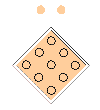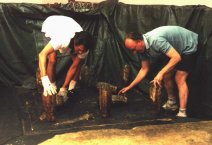londonskittles.co.uk


| Home | News | About London Skittles | Members Section | History of the Game | Links | Glossary |
londonskittles.co.uk |

|
 |
||||||
|
||||||||
| Alien Abduction | Although steeped in tradition, never let it be said that London Skittles is locked into the past. Kristoffer Ohlin, who seems adept at knocking out the middle pin, introduced this new term to the skittles lexicon. |  |
| Big Bog, The | See the diagram. Known in less polite circles as 'The
Elephant's Arsehole'. It is not possible to get all three except by a fluke. A right-handed player would go for the right winger and try to get the long double, as in this video clip. |
 |
| Bolter | A cheese which passes through all the
pins without knocking any over. The expression for a bolter is currently the expletive 'bollocks' preferably shouted with gusto. The origins of this outburst can be found in the Garrick Club circa 1875, not I might add whilst watching or playing the game of skittles, but the more sedate billiards. A pyramid of reds and several coloured balls were involved in this particular game, and contained the following rule...:- 'In the event of the yellow ball being involved in a foul stroke, it is the custom for the watchers to cry out the word 'bollocks'.' This rule was abandoned within the billiards fraternity only to be later included into the game of London Skittles as a lusty expression of disgust for the player who had thrown a 'bolter' or a 'blow through'. |
|
| Broken frame | The combination of pins left after the opening shot (or shots). Also known as a ‘leave’. Many of these have individual names, see Big Bog (The), Fender, Gates of Hell, London Bridge, Rooks, Tadpole and Waterloo. | |
| Cheese | The object named because of its shape, which is thrown at the pins. It is made of lignum vitae, a dense tropical hardwood. Cheeses vary in size and exact shape, most weighing about 10lb (4.5kg). | |
| Complimentary score | The score awarded when a player has already won or already lost an end but has a gettable shot left. See the explanation in 'How the game is played'. | |
| Dead | Pins which fall but stay on the frame after the opening shot. These are not removed and in subsequent shots may be a help (see Lovely dead) or a hindrance (see Robbing dead). | |
| Eight Pin | A shot which knocks down all the pins but one. Also called ‘two with a dot’. Here's a video clip | |
| Feet! | A warning call given when a cheese being returned jumps out of the alley and heads towards a bystanders feet, beer or other delicate parts. | |
| Fender | The diagram shows the fender normally encountered by a left hander. |  |
| Floorer | A shot which knocks all nine pins over as in this video clip. | |
| Gates of Hell | See the diagram. Almost impossible to get without the aid of a dead. |  |
| Hornbeam | The wood the pins and the frame are made from. This is a hardwood, related to beech. | |
| Landlady's daughter | Unlike some of the other terms, this refers not to the pins left standing after a throw but is a coarse reference to two fallen pins lying more or less side by side. The advice given about how to make use of these dead pins is often equally coarse. | |
| Lignum vitae | The tropical hardwood the cheeses are made from. It is probably the heaviest wood in the world - it sinks in water (S.G. 1.3). Also it allegedly has some remarkable medicinal properties - have a look at the Lignum Vitae page on the St Barths website. | |
| London Bridge | See the diagram. If this is left after your opening shot, there's little you can do but step out for four. In this slow motion video you can see a fine example where the player has successfully gone for half the London Bridge. |  |
| Lovely dead | A cry which goes up when a shot leaves a dead pin on the frame well placed to be used to pull off an otherwise difficult shot. Sometimes used ironically. | |
| Novices | The diagram shows a right hander's novices. This is a comparitively easy shot (hence the name). Striking the front pin on the right, the pin takes the winger and the cheese takes the back pin. |  |
| Pot | A courtesy extended to ones opponent in a friendly game. Say player A leaves a difficult pair and would normally ‘step out for four’, player B may say ‘four for the pot’. This allows player A to go for the shot and try for a three. He keeps the three if he gets the pair but still gets four even if he misses both. | |
| Robbing dead | A dead pin which obstructs the cheese or another pin on a subsequent throw so that the player fails in a shot which would otherwise have succeeded. | |
| Rooks | See the diagram. There are two techniques for this shot, either a very low shot ('bundling them up') or a high shot on the top of the front pin. In either case the shot has to be dead straight or the cheese will go to one side of the back pin and the pin to the other. |  |
| Standing dead | Rarely, a pin may be knocked over, roll on its head and stand up again. This is considered a dead pin; it stays on the frame but does not have to be knocked over again. | |
| Step out (for three/four) | Traditionally your turn ends when you step out of the alley. Say you have taken seven pins with your first throw and left a difficult pair standing. If you consider it’s more likely that you would miss this pair altogether than get them both down with your next shot, you would “step out for three”, i.e take a score of three (one throw plus two pins left standing). This video clip shows a case in point. | |
| Sticker | Unlike ten-pin bowling, London Skittles has no automatic resetting mechanism. The stickers are the guys who stand at the end of the alley standing the pins back up and returning the cheese. The usual convention is that you have to stick a game before playing. | |
 |
||
| Tadpole | The diagram shows the tadpole normally encountered by a right hander. |  |
| Waterloo | See the diagram. This leave was named after a famous victory, not in 1815, but in a match at a pub in the Waterloo Road. This combination was left in the last end of the last game. The player got it, clinching the match. |  |